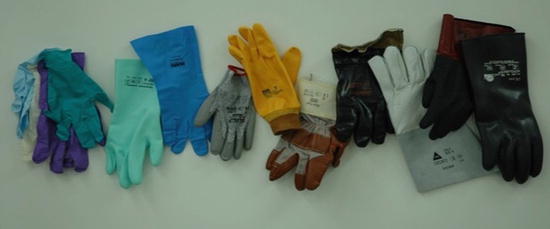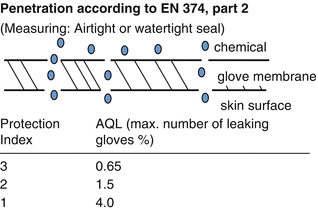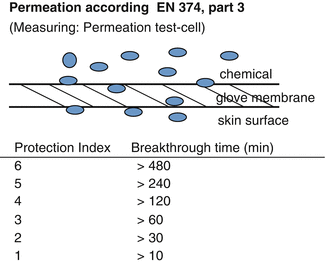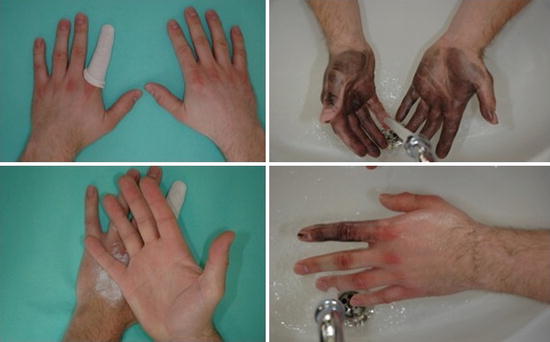Fig. 24.1
Hierarchical skin protection strategy
Worker-related strategies, for example, skin protection, should be optimized by choice of adequate gloves, barrier creams, emollients, and skin cleaning products and by workers education to improve their motivation to practice skin protection and to avoid application errors [32, 44]. It is also recommended to summarize all skin protective measures in a skin protection plan that includes handwashing, skin protection (gloves and barrier creams), and skin care.
Personal skin protection is intended to protect the skin from harmful substances, and systematic skin protection is based on three basic components: (1) skin protection, (2) skin cleansing, and (3) skin care [19, 42]. For all dimensions of personal skin protection, a careful selection of products is needed as well as a thorough instruction of the persons who are to apply the skin protection measures. In the use of skin protection, a careful selection along standardized criteria (if available) is needed in all types of protective measures.
24.2 Chemical Protective Gloves
Gloves are the most important and most effective option of skin protection [29]. There is a big range of different glove materials (e.g., nitrile, neoprene, natural rubber latex, PVC, PVA, laminated film, vinyl, butyl, or Viton®/butyl gloves) and properties of different types of gloves (e.g., disposable gloves, single-use gloves, see Fig. 24.2). There is no universally suitable glove for all chemicals and for all application situations. Important factors for providing protection are the penetration capacity for water and permeability to chemicals. The amount of protection provided by PPE is material-hazard specific. That is, protective equipment materials will protect well against some hazardous substances and poorly, or not at all, against others. In addition, undesirable effects of glove wearing must be taken into account and avoided (e.g., occlusion effect, latex and contact allergy due to ingredients of glove materials, see Wulfhorst et al. [44]). As mentioned above, application errors are common and cause the desired effect of protecting ad absurdum (see below).


Fig. 24.2
Wide range of glove materials and product types
OSHA’s personal protective equipment standard (29 CFR 1910.138) specifically addresses the need for hand protection or chemical protective gloves [38]:
(a)
Appropriate hand protection must be worn when the hands are exposed to hazards such as skin absorption of harmful substances, severe cuts, lacerations or abrasions, punctures, chemical or thermal burns, and harmful temperature extremes.
(b)
Employers must base the selection of appropriate hand protection on an evaluation of the performance characteristics of the hand protection relative to the task(s) to be performed, conditions present, duration of use, and the hazards and potential hazards identified.
This rule makes it mandatory to match the right glove material with each application or task. This includes assessing the job for chemical exposures and then selecting the appropriate, chemical protective glove based on material, thickness, length, and other traits.
By the Health and Safety Executive [13], five factors are named that has to be taken into consideration to choose an appropriate glove:
Identify the substances handled.
Identify all other hazards.
Consider the type and duration of contact.
Consider the user size and comfort.
Consider the task.
Core Message
Inappropriately selected or misapplied gloves may increase the risk for contact dermatitis due to the following:
Contamination of the inside glove could increase exposure to hazardous substances in comparison to no glove wearing.
The occlusion effect due to extended wearing times that can lead to an excessive moisturizing of the horny layer.
Allergens that are ingredients of glove material [44].
24.2.1 Requirements and Standards
In many countries, requirements for gloves are standardized due to regulations [5, 6]. In Europe, gloves are covered by the PPE Directive 89/686/EEC “Gloves intended for protection”; the comparable US standard is fixed in the Occupational Safety and Health Standards 1919: Personal Protective Equipment/Hand Protection, 1910.138 [15, 38].
The European Directive is based upon the existence of European standards to define specifications or performance levels for the products.
Under European regulations, three levels of risk and seriousness of the potential injury have to be distinguished, and the protective gloves are to label into three categories that require different amounts of quality proofs:
Category I: Gloves of simple design – suitable for minimum risk.
Category II: Gloves of intermediate design – for intermediate risk.
Category III: Gloves of complex design – for protection against high risks, i.e., where skin exposure would result in irreversible damage to health or possibly death.
Referring to Tab. 1 only for category III (protection against high risks), gloves have to be labeled with the number of a certified testing institute, according to the results of testing penetration and permeation properties of the gloves, and different pictograms have to be marked on each glove, see Table 24.1 [Directive 89/689/EEC].
Table 24.1
Identification of gloves according to European regulations
 | Indication of conformity with the fundamental requirements according to the European Directive 89/686/EC, the manufacturer is obliged to affix the CE marking on the gloves/the glove packaging. The 4-digit number refers to a certified test institute which has done the tests according to DIN EN 374 and to other regulations |
 | Chemical resistant glove accompanied by a 3-digit code referring to the code letters of three chemicals from a list of 12 standard defined chemicals, for which a breakthrough time of at least 30 min has been obtained in the permeation test according to DIN EN 374 |
 | Low chemical resistant or “waterproof” glove which complies with the penetration test (AQL) according to DIN EN 374. These gloves normally have not achieved a breakthrough time of at least 30 min against at least three chemicals from the defined list or were not tested for permeability |
 | “Microorganism” resistant glove, glove has to conform to at least the performance level 2 (AQL) for the penetration test according to the DIN EN 374 |
 | This pictogram means that further information/instructions are to be obtained by the manufacturer |
Penetration refers to the passage of chemicals through macroscopic holes or pores. Penetrability can result from a manufacturing process (a material defect) or from faulty or lengthy storage.
The results of an air or water leakage test are described as acceptance quality level (AQL) which names the number of leaking gloves according to EN 374-2 (see Fig. 24.3).


Fig. 24.3
Penetration of gloves: acceptance quality levels (Adapted from Wulfhorst et al. [44], 983–1016)
Permeation refers to the migration of chemicals through the protective glove material on a molecular level. The results of determination of the breakthrough time in minutes are described in six classes according to EN 374-3 (see Fig. 24.4).


Fig. 24.4
Permeation of gloves: Breakthrough time and protection index (Adapted from Wulfhorst et al. [44], 983–1016)
24.2.2 Choosing the Right Chemical Protective Gloves
As mentioned above, it is very important to match the right glove material with each application of chemicals. Mellström and Bowman [24] presented a detailed description of the materials used for gloves. In Table 24.2, some glove material and applications are listed according to the American National Standard for Hand Protection Selection Criteria [2].
Table 24.2
Glove material and applications. Source: ANSI/ISEA 105-2011, American National Standard for Hand Protection Selection Criteria
Glove material | Applications |
|---|---|
Butyl | A synthetic rubber material that offers the highest permeation resistance to gas and water vapors. Especially suited for use with esters and ketones |
Neoprene | A synthetic rubber material that provides excellent tensile strength and heat resistance. Neoprene is compatible with some acids and caustics. It has moderate abrasion resistance |
Nitrile | A synthetic rubber material that offers chemical and abrasion resistance, a very good general duty glove. Nitrile also provides protection from oils, greases, petroleum products, and some acids and caustics |
PVC (polyvinyl chloride) | A synthetic thermoplastic polymer that provides excellent resistance to most acids, fats, and petroleum hydrocarbons. Good abrasion resistance |
PVA™ (polyvinyl alcohol) | A water-soluble synthetic material that is highly impermeable to gases. Excellent chemical resistance to aromatic and chlorinated solvents. The glove cannot be used in water or water-based solutions |
Viton® | A fluoroelastomer material that provides exceptional resistance to chlorinated and aromatic solvents. Viton is very flexible but has minimal resistance to cuts and abrasions |
Silver Shield®/4H | A lightweight, flexible laminated material that resists permeation from a wide range of toxic and hazardous chemicals. It offers the highest level of overall chemical resistance but has virtually not cut resistance |
By regarding lists of glove materials with their general applications, it has to be taken into account that the protective effect of different glove materials against hazardous substances depends on the one hand on the type and composition of the material but on the other hand, the protective effect of the same material can differ due to manufacturing processes. In addition, the protective effect depends on the thickness of the glove material [25].
To help in the selection of appropriate gloves, manufacturers of gloves provide charts and computer software. Some general databases can be referred to get informations about selected chemicals (e.g., see [4]).
In Europe, it is in the responsibility of the manufacturer who puts a chemical on the market to investigate and document efficient gloves to protect the user of the hazardous chemicals. Minimum standards of effective protective glove or product names of effective gloves are documented in the safety data sheets [21].
24.3 Barrier Creams
The effectiveness of barrier creams is of conflicting evidence [19, 20]. The idea of the mechanism of action of barrier creams during the recent years has been that they are effective in a physical way because due to their composition, a diffusion barrier against the offending irritant is built up. According to this idea, hazardous substances of similar physicochemical properties are grouped (e.g., water miscible or non-water miscible) to simplify the product recommendation [18]. However, the theory that the product only builds up a physical barrier between the skin and the irritant and the formulation remains unchanged after the product has been applied to the skin could not be validated [12]. Rather, it should be taken in consideration that in many workplaces, skin contact to both water-miscible and non-water-miscible irritants takes place in exchange. Moreover, it has to be considered that skin protection products cannot offer protection comparable with gloves, marketing promises like “the barrier creams is an invisible glove” may feign a seeming protection, but barrier creams do not act as the protective shield which may be claimed, and other protective measures, such as wearing gloves, will still be required. On the other hand, barrier creams are often the only realizable preventive measure in the case of occupations with an increased requirement for sense of touch and finger mobility or when working at rotating machines [44]. So applying barrier cream before work can make cleaning the skin easier, for example, after working with grease or oil, see Fig. 24.5 ([28], Kütting).









